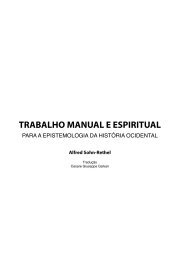Perversion the Social Relation
Perversion the Social Relation
Perversion the Social Relation
- No tags were found...
You also want an ePaper? Increase the reach of your titles
YUMPU automatically turns print PDFs into web optimized ePapers that Google loves.
164 Michael P. Biblerso sweet" (204). The initial violence of Nat's response corresponds to<strong>the</strong> code of interpersonal behavior established within <strong>the</strong> slave institution.Although his own master is fairly tolerant, violence never<strong>the</strong>lessremains <strong>the</strong> primary method of control and punishment within slaveryat large, and Nat reiterates <strong>the</strong> lesson almost perfectly. But his act ofstriking Willis also fosters a painful identification with him on <strong>the</strong> basisof <strong>the</strong>ir shared status at <strong>the</strong> bottom of <strong>the</strong> social hierarchy. Himself aslave, Nat cannot assert any real power over Willis by physically correctinghis behavior. The blow's symbolic emptiness thus pairs with Willis'shurt feelings to remind Nat of his own disenfranchisement and pain. Asa result, <strong>the</strong> scene quickly turns into a description of some o<strong>the</strong>r kindof relationship based in this identification—not quite <strong>the</strong> surrender ofei<strong>the</strong>r man so much as <strong>the</strong> simple sharing of pleasure between <strong>the</strong>m.Within <strong>the</strong> hierarchies of <strong>the</strong> slave plantation, Willis and Nat's equalstatus as black male slaves creates a situation in which <strong>the</strong>ir identitiesappear to cancel each o<strong>the</strong>r out. Although <strong>the</strong>re are real differences between<strong>the</strong> men, <strong>the</strong> cultural nexus of slavery renders those differencesirrelevant because <strong>the</strong>y share <strong>the</strong> same fundamental relationship to <strong>the</strong>networks of power. Without a significant racial, gender, class, or evenage difference to unbalance <strong>the</strong> power relation between <strong>the</strong>m personally,and without a narrative voice to infer one, <strong>the</strong> two men thus sharea moment of homo-ness in which <strong>the</strong>ir homosexual union renders <strong>the</strong>iridentities not only <strong>the</strong> same, but also virtually interchangeable. In much<strong>the</strong> same way that <strong>the</strong> institutions of slavery prompt an initial violentresponse from Nat, <strong>the</strong>y also foster <strong>the</strong> realization and <strong>the</strong> pleasure ofa profound mutuality and sameness that appear to contradict <strong>the</strong> logicof violence. This experience of homo-ness paradoxically blurs, and evenseems to eliminate, <strong>the</strong> very categories of identity that define <strong>the</strong> twomen because <strong>the</strong>ir localized sameness actually neutralizes <strong>the</strong> axes of differencethat support definition. Moreover, this evacuation of identitiesderives a large part of its power not so much from <strong>the</strong> simple recognitionof similarity as from <strong>the</strong> temporary release from <strong>the</strong> self throughsexual orgasm. Within <strong>the</strong> act of <strong>the</strong>ir mutual masturbation, <strong>the</strong>ir identitiesdo not remain distinct, but merge into one, so that <strong>the</strong> sexual act<strong>the</strong>y perform on each o<strong>the</strong>r becomes an extension and repetition of <strong>the</strong>sexual acts <strong>the</strong>y have previously performed on <strong>the</strong>mselves. Nat's contactwith Willis represents an extension of both men's selves in <strong>the</strong> psycho-








